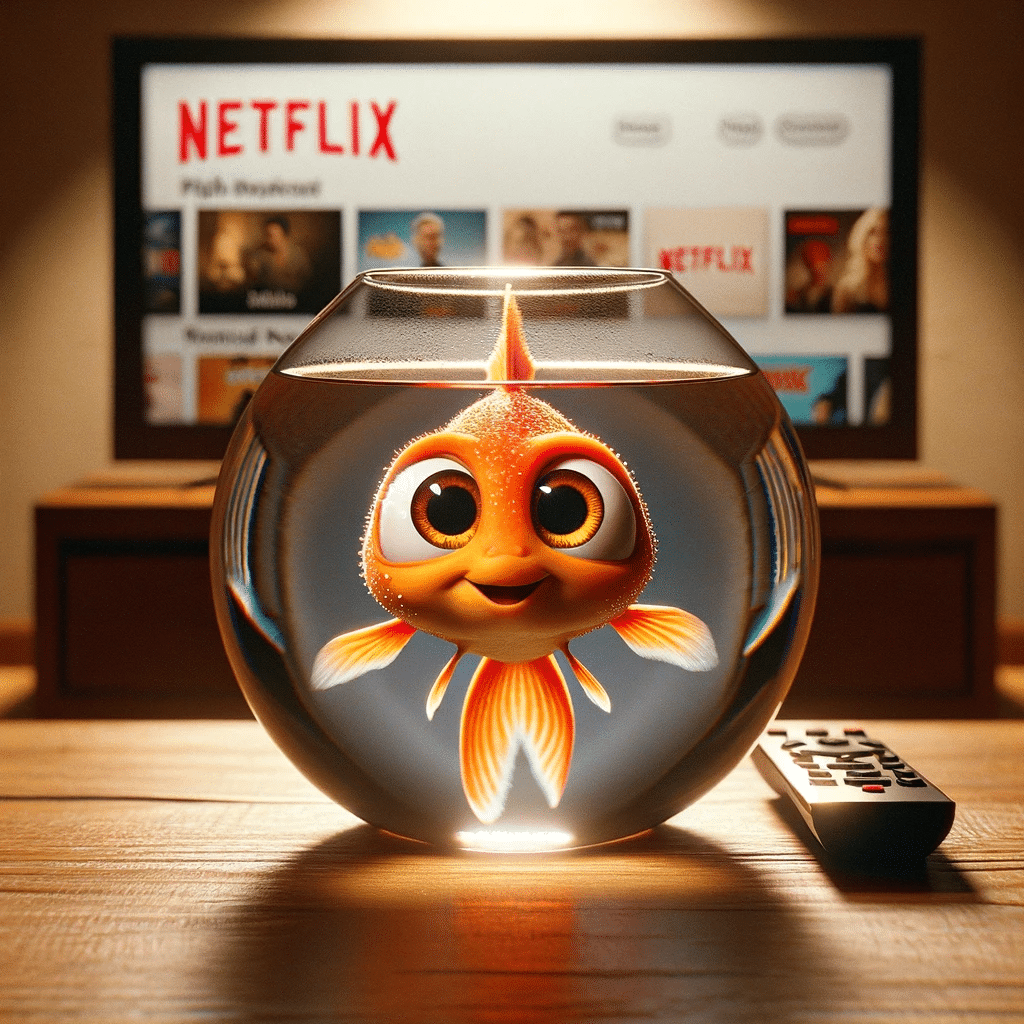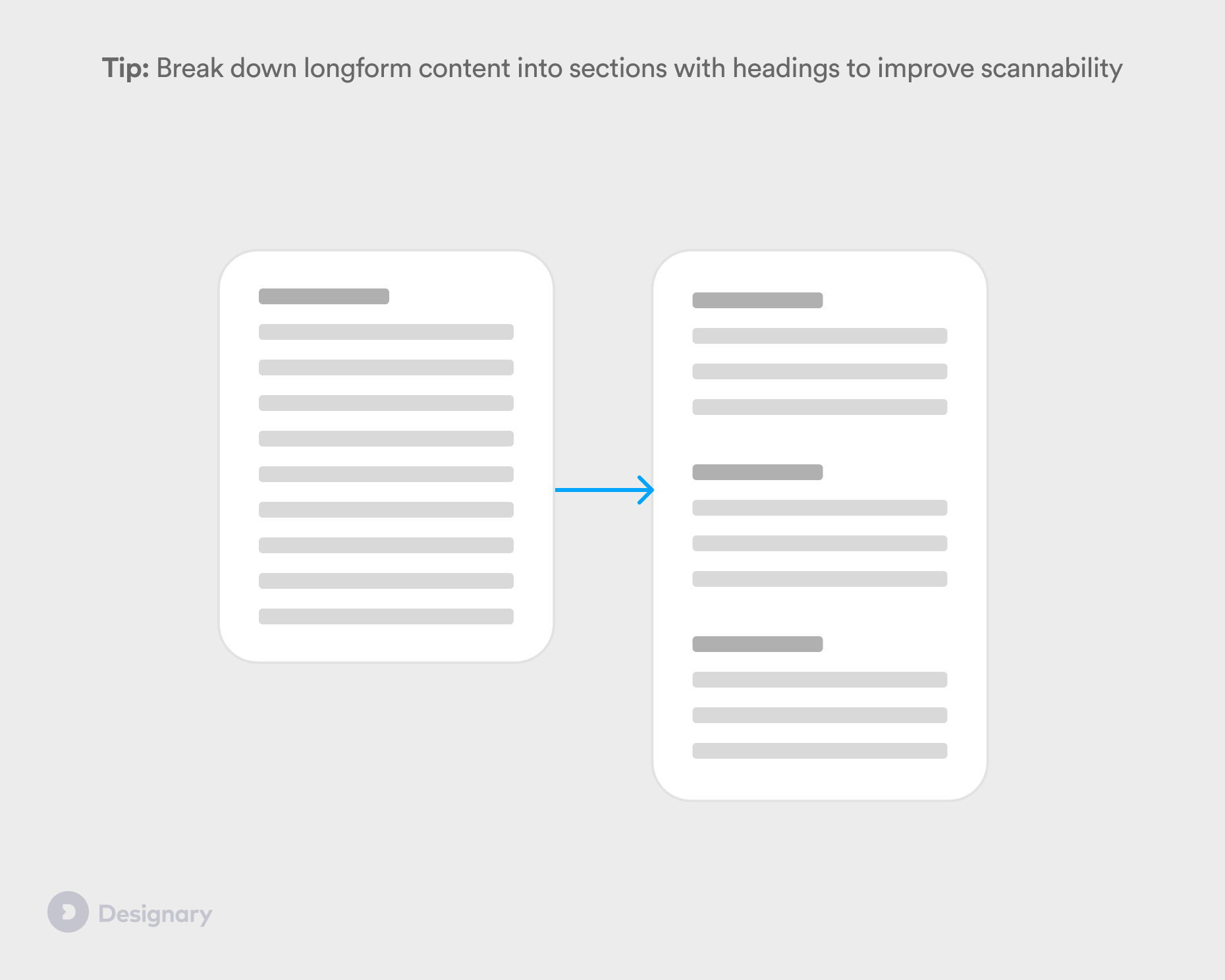Welcome to the high-speed information highway of B2B marketing, where the currency is content and attention spans are the stocks—volatile, unpredictable, and oh-so-precious.
If your content were a novel, it might never leave the shelf, because in the breakneck world of business, who has the time for War and Peace? This is a world of tweets, not tomes; bullet points, not babbles.
The Importance of Scannability in B2B Marketing
Scannability isn’t just a buzzword—it’s the secret handshake in the B2B marketing speakeasy.
It’s about making your content not just seen but savored in nanoseconds.
It’s a necessary rebellion against the information overload that bombards our beleaguered business brains daily. Why? Because your content isn’t just competing with your competitors.
Oh no, it’s up against cat videos and last night’s sports scores, too. Making your message pop in this cacophony of clicks is less about shouting louder and more about striking smarter.
The Challenge of Limited Attention Spans
Studies suggest that the average human attention span is now shorter than that of a goldfish, which is not exactly known for its ability to binge-watch Netflix.
This presents a peculiar puzzle:
How do you get a goldfish to buy into your value proposition?
The answer lies in crafting your message to be a slippery, shiny object that catches the eye long enough to make an impression.

The Benefits of Easily Digestible Content
In a banquet of words, scannability is the art of creating appetizing bite-sized portions.
Easily digestible content means no mental indigestion for your reader—just a smooth glide down the gullet. It’s the tapas bar in a world of all-you-can-eat buffets.
And the digestibility factor has a direct line to the bottom line.
Content that can be scanned is content that can convert.
It leads to longer dwell times, higher engagement, and, crucially, more robust lead generation. Because when you make the complex simple, you make the implausible possible.
So strap in, dear marketer, as we embark on this journey to master the art of scannable content. It’s time to weave through the fabric of digital content with the precision of a tailor and the flair of a designer. This isn’t just about making a mark; it’s about making a masterpiece on the canvas of conciseness.
Let’s cut the fluff and dive in.
Unlocking the Secrets of the B2B Audience
Embarking on the B2B Decision-Making Quest
In the realm of B2B, decision-making is no solo sprint; it’s a team relay race with multiple baton passes.
Your content is the track on which they run:
- The Stakeholder Symphony: In the orchestra of decision-makers, every instrument plays a critical role. Understand that your content must resonate not just with one, but with the entire ensemble.
- ROI Dreamweavers: These are the folks for whom a good night’s sleep is predicated on clear-cut metrics of success. Your content should not only sing but also bring measurable ROI to their bedside table.
- The Caffeine Kick: If your audience sips on triple-shot lattes, your content needs to match that intensity. Make it rich, bold, and something that can be consumed between sips, giving them the jolt they need to stay engaged.
Zeroing in on Information Desires
Getting to the heart of what your audience craves informationally is like mapping the human genome—complex but not impossible.
Here’s how to crack the code:
- Executive Efficiency: For the leaders with calendars denser than a Tolkien novel, present key takeaways that can be grasped faster than you can say “next meeting.”
- The Analyst’s Eye: Cater to those who scrutinize data like fine art. Lay out the numbers as if they’re part of a grand mosaic, revealing the bigger picture through detail and design.
- Culinary Content Crafting: Much like a bespoke diet, your content should cater to the unique appetites of your readers, whether they favor quick snacks or a full-course meal of information.
Mastering the Art of Scannable Content in Lead Nurturing
It’s time to turn scannable content into your lead-nurturing secret weapon, enticing prospects closer to ‘sold’ with every glance:
- First Impressions at Light Speed: Think of your content as a series of first dates, where you only have a few moments to make your mark. Use impactful headers and engaging visuals to make each introduction count.
- Showcasing the Highlights: Put your key messages in the spotlight. Use bullet points, bolded phrases, and infographics to draw the eye to the value propositions that will turn heads and hearts.
- Curiosity Without the Clutter: Pique interest by offering enough to tantalize but not overwhelm. Think of it as the content equivalent of a movie trailer—giving just enough to intrigue without spoiling the plot.
Crafting Content for the Quick Glance: Principles of Scannability
Dive into the scannable content playbook, where clarity is king and visual hierarchy dictates the pecking order.
Let’s finesse the fine art of getting your point across before your reader’s next blink.
Clarity Above All: The KISS (Keep It Simple, Sweetheart) Strategy
Clarity in content is like a clean windowpane—viewers should hardly notice it’s there.
It’s about finding the shortest distance between two points: their question and your answer.
- Directness is Darling: Speak plainly, as if you’re explaining your product to a friend who’s more interested in the bottom line than the fluff.
- No Jargon Jamboree: Industry terms can be the equivalent of insider slang. Use them sparingly, like seasoning, not the main course.
- Sentence Slim-Down: Each sentence should be a lean, mean, value-packed machine. If it doesn’t serve a clear purpose, it’s just taking up valuable real estate.
The F-Pattern: The Natural Flow of Digital Eyes
Our online reading behavior mimics a particular letter of the alphabet, and you guessed it—it’s the ‘F’.
The bottom of a paragraph is where attention spans go to die.
Content layout should bow to this natural reading rhythm.
- Start Strong: Knowing that eyes typically scan the top horizontal line first, front-load your heavyweight information.
- Sideways Glance: The next point of interest lies in the first few words of subsequent lines, so lead with strong headers or bullets.
- Final Flourish: The bottom horizontal sweep catches less attention, making it prime real estate for supporting details or a strong call-to-action (CTA).
The Role of Visual Hierarchy: Leading the Eye with Design
Visual hierarchy is the tour guide for your content’s museum.
It highlights the masterpieces and guides the visitor through the exhibit.
- Bold Leaders: Employ bold fonts and colors to make key points stand out like the CEO in a boardroom.
- White Space, the Silent Hero: Like a good pause in a speech, white space gives the reader time to breathe and the content room to shine.
- Imagery as Landmarks: Use images, infographics, and icons as visual pit stops, providing a break from text while reinforcing your message.
Following these principles, you’ll craft scannable content that hooks B2B readers and keeps them engaged, all while efficiently marching them down the conversion path.
It’s about making every element count, every word earn its keep, and every visual communicate a thousand words.
Scannable Website Content: Nailing the Quick-Read Recipe
Prepare to transform your website into a scannable content buffet, where every element is a delicacy designed for easy consumption.
Let’s garnish your digital presence with the zest of clarity and a dash of interactive zest.
Headings and Subheadings: The Signposts of Content
Headings and subheadings are your readers’ GPS, guiding them through the landscape of your content.
Make them count:
- Attention-Grabbing Headers: Craft your headers like newspaper headlines—compelling enough to stop scrolling thumbs in their tracks.
- Subheading Spice: Layer your content with subheadings that add flavor and guide readers through your textual feast, giving them the full tour, aisle by aisle.
Bullet Points and Numbered Lists: The Organizational Artisans
Bullet points and numbered lists are the Marie Kondos of content organization—they spark joy by tidying up complex information.
- Bullet Beauty: Turn your content into an easy-to-scan checklist that can be processed at a glance, making readers feel like productivity ninjas.
- Numbered Nuggets: Use numbered lists to create a sense of order and progress, guiding your reader through steps or key points like breadcrumbs through the forest of information.
Strategic Use of Keywords: The Skimmer’s Beacon
In the sea of words, keywords are the lighthouses guiding your time-constrained readers to safe harbors of relevant content.
- Skim-Friendly Keywords: Plant keywords where eyes naturally fall—the beginning of lines and headings—to light up the path for skimmers searching for solutions.
- Density with Purpose: While SEO whispers sweet nothings about keyword density, remember that readability is the ultimate seducer. Keep it natural, keep it clear.
The Power of White Space: The Content Breather
White space is the unsung hero of design, the space between the notes that makes the music of your content sing.
- Whitespace Whispers Calm: Allow ample room around text and between lines, letting your content breathe and preventing reader suffocation.
- The Pause Button: Strategic white space acts as a pause button, giving readers a moment to reflect and absorb before moving on.
Incorporating Visuals: A Picture Paints a Thousand Scans
In the currency of attention, images, infographics, and videos are the gold coins.
They catch the eye and convey complex messages with simplicity and impact.
- Image Impact: Use relevant images to break text, offer rest for the eyes, and communicate in a universal language that transcends the barrier of wordy explanations.
- Infographic Intrigue: Condense data into infographics that tell a visual story, engaging the reader with information dressed in its Sunday best.
- Video Velocity: Videos are like content express trains, delivering your message with speed and precision, ideal for visitors who would rather watch than read.
Interactive Elements: The Digital Handshake
Interactive elements are the friendly ushers of your content, reaching out for a digital handshake and guiding users down the path you desire.
- Engagement Widgets: From calculators to quizzes, embed interactive widgets that turn passive reading into active engagement.
- CTA Charisma: Calls-to-action with interactive flair not only catch the eye but invite the click, transforming readers into actors on the stage of your marketing strategy.
With these scannable strategies in your arsenal, your website content will not just be read—it will be experienced.
It will beckon the busy, woo the weary, and charm even the most hurried of digital travelers through your virtual door.
Scannable Ads: Mastering the Swift Glance
Strap in as we decode the hieroglyphics of scannable B2B ad design.
It’s not just about catching the eye, but captivating the constantly ticking mind of a business connoisseur.
The Essentials of B2B Ad Design
Your ad is the elevator pitch of the digital realm—a brief moment to charm and inform:
- Brand Consistency: Your ad is an ambassador dressed in your brand’s attire, reflecting your company’s values and aesthetics at a glance.
- Simplicity Speaks Volumes: In a landscape crowded with complexity, be the Zen garden. Offer a clear, uncluttered design that’s a breath of fresh air in a smoggy city of ads.
- Context is Key: Craft your ad with the location in mind, whether it’s nestled in an industry blog or boldly displayed on a LinkedIn sidebar.
Text and Typography Best Practices
The pen is mightier than the sword, and in our case, the typeface is mightier than the text:
- Font Fluency: Choose typefaces that don’t just shout, but converse with the reader. Legibility is your wingman here.
- Hierarchy Hustle: Arrange text sizes in a hierarchy that directs the reader through your message with the precision of a symphony conductor.
- Brevity is the Soul of Wit: Shakespeare might as well have been a B2B marketer. Keep ad copy short, sweet, and punchier than a boxing glove filled with one-liners.
Call-to-Action: Making It Pop and Click
The CTA is your ad’s climax—the moment where interest turns into action:
- Standout Buttons: Your CTA button should be the loudest in the room, not with noise, but with visual appeal that draws fingers like magnets.
- Command with Clarity: Use action verbs that compel and convert. Think ‘Discover,’ ‘Get,’ ‘Start’—verbs that move mountains, or at least mouse cursors.
- Urgency is Your Ally: Create a sense of now or never. Phrases like ‘Limited Offer’ or ‘Book a Demo Today’ should carry the excitement of a midnight launch.
Using Colors and Contrast to Guide the Eye
Color and contrast aren’t just for show—they’re the guiding lights through your ad’s story:
- Color with Purpose: Select colors that evoke the desired emotion and reaction. Blues for trust, greens for growth, reds for urgency—the color wheel is your oyster.
- Contrast Creates Interest: Play with light and dark, bold and subtle, to create depth and guide the eye to the star of the show—your key message.
- Spotlight with Saturation: A pop of color in a sea of monochrome can be the beacon that brings the click home.
With these elements in your B2B ad design toolkit, you’ll create not just ads, but visual haikus that resonate with the efficiency-obsessed, value-driven B2B audience.
Your ads will no longer be mere signposts; they’ll be irresistible lures, pulling in those high-value clicks with the gravitational force of a business black hole.
Scannable Sell Sheets: The Art of the Swift Sell in the Digital Age
Let’s roll out the parchment and ink as we step into the tactile realm of print, where scannability meets the handshake and the paper rustle in a dance of persuasion.
Understanding the Role of Print in a Digital World
Even in our pixel-perfect era, print holds a tangible charm:
- Tangible Trust: There’s a credibility to the heft of paper, a permanence that digital dances around but rarely pins down.
- Digital Complement, Not Competitor: Use print as the acoustic version of your digital electric guitar—each has its place, and together, they harmonize.
- Niche Audience Navigator: Print remains a preferred medium in certain B2B niches, where the ritual of hand-to-hand exchange still holds court.
The Anatomy of a Scannable Sell Sheet
Crafting a sell sheet that catches the eye is like mapping the human genome—complex, but we’ve cracked the code:
- Headline Hierarchy: Like chapters in a novel, headlines guide the reader through the narrative of your sell sheet, from the gripping intro to the satisfying conclusion.
- Bulleted Benefits: Unleash bullet points to parade your product’s benefits in a show-stopping catwalk of clarity.
- Data Visualization: Let charts and graphs do the heavy lifting of data-dense materials, transforming numbers into visual narratives.
Balancing Comprehensive Information with Skimmability
The magic lies in the mix—a cocktail of depth and digestibility:
- Info-snacks: Serve up bite-sized chunks of information that satisfy but don’t overwhelm—the hors d’oeuvres of data.
- White Space Wisdom: Even on paper, white space wields power, giving the reader’s eye a well-deserved pit stop.
- Callouts for Clarity: Use callouts to highlight key information—think of them as your sell sheet’s billboards, advertising the best deals on offer.
Your sell sheets and print materials, infused with these principles of scannability, become not just informative leaflets, but efficient and engaging touchpoints that respect the reader’s time while showcasing your B2B solution’s value.
They stand as a testament to the fact that even in our screen-saturated world, the printed word wields a weight that can tip the scales in your favor.
Copywriting Strategies: Words That Work at Warp Speed
Rev up your writing engines and get ready to craft content that skims the cream off the top.
Writing for the B2B Skimmer: Tips and Tricks
Hook your busy bees with content that sticks:
- Kickoff with a Bang: Start with the most electrifying fact or stat you’ve got—make it as attention-grabbing as a headline ticker in Times Square.
- Active Voice, Passive Interest: Use the active voice to charge up your sentences with energy. Let’s ditch the corporate monotone, shall we?
- Bulletproof Bullets: Break down complex info into bullet points that can be digested faster than a power lunch.
The Inverted Pyramid Style in B2B Content
Flip the script—literally—with this journalist’s go-to structure:
- Lead with Gold: Start with the most valuable info up top. It’s like giving your readers the crown jewels before the royal tour.
- Whittle Down the Waffle: As you move down the page, get into the finer details for those who stick around for the after-party.
The Importance of Content Chunking
The Designary gets it, turn your content into a snackable spread:

- Paragraph Punch: Keep paragraphs short and stout, like little teapots of information ready to pour out.
- Headline Harmony: Ensure your headlines sing in tune with the content that follows—no bait and switch here.
Utilizing Pull Quotes and Sidebars for Emphasis
Make important points pop and sizzle:
- Pull Quotes to the Podium: Extract those zinger quotes or stats and give them a spotlight. It’s like saying, “Hey, don’t miss this!” with neon lights.
- Sidebar Showtime: Use sidebars for quick info nuggets, bios, or asides that complement the main act but deserve their own stage.
Inject these techniques into your B2B copywriting, and you’ll serve up scannable content that’s as delightful to skim as it is to deep-dive.
It’s about making every word count and every second of your reader’s time feel like an investment, not an expense.
The Litmus Test of Brevity: Tuning Content for Rapid Consumption
Testing and optimization aren’t just the icing on the cake; they’re the critical taste-test before your scannable content goes to the grand banquet.
Tools and Metrics for Measuring Content Performance
Donning the lab coat of analytics:
- Heatmap Heroes: Employ heatmaps to visualize where eyes linger and fingers click—data doesn’t lie when it comes to hot spots and deserts.
- Engagement Envoys: Track metrics like time on page and bounce rate to gauge the gravity of your content—do visitors stick like glue or bounce like a rubber ball?
- Conversion Counters: Use conversion rates to measure the ultimate goal—does the content lead to a handshake deal or a wave goodbye?
A/B Testing: Finding What Works Best for Your Audience
The split-test saga:
- Duel of Headlines: Pit two headlines against each other in the arena of public opinion; may the most clickable win.
- Call-to-Action Confrontation: Which CTA leads to action, and which to apathy? A/B testing will tell you before you roll out the red carpet.
- Format Faceoff: Test long paragraphs against short, videos versus images, or bullet lists against numbered—only one format will triumph in readability.
Iterative Design and Content Updates
The 5-second test enters here as a gladiator of first impressions:
- 5-Second Rule: In the same time it takes to decide the fate of floor food, test if key messages in your content pass the blink-of-an-eye trial. Does the value proposition hit home in a single glance?
- Feedback Loops: Use real-world feedback to tweak and refine. Content isn’t set in stone; it’s clay to be molded by the hands of audience reaction.
- Continuous Content Evolution: Like a fine wine or a vintage cheese, let your content age gracefully through constant updates and optimization. Today’s trends are tomorrow’s history; stay ahead.
By rigorously testing and optimizing, your scannable content isn’t just a static entity—it’s a living, breathing conversation with your audience, constantly evolving to meet the rapid pace of the business world’s consumption habits.
The Final Scan: Embedding Brevity and Impact into B2B Narratives
As we draw the curtain on our scannability saga, it’s clear that the pithy and punchy will inherit the Earth—or at least the attention of B2B buyers.
Let’s encapsulate our journey into integrating a scan-friendly approach into our content DNA.
Integrating Scannability into Your Content Strategy
Embed scannability deep into your content strategy’s marrow:
- Start with Structure: Ensure that scannability isn’t an afterthought but the scaffolding upon which your content is built.
- Train the Team: Equip your writers and designers with the tools and knowledge to consistently produce content that meets the scannable standard.
- Policy of Precision: Implement guidelines that champion brevity and clarity, turning them into the guiding principles of your content creation ethos.
The Continuous Evolution of B2B Content Consumption
Remember, the landscape is ever-shifting:
- Stay Agile: As B2B content consumption patterns evolve, so must your strategies. Keep a finger on the pulse of the latest trends and be ready to pivot.
- Embrace Innovation: New formats and platforms emerge, offering fresh venues for scannable content—leverage them to maintain a cutting-edge presence.
- Educate and Adapt: Keep learning from both successes and missteps, and let that knowledge inform your content’s evolution.
Call to Action: Auditing Your Current Content for Scannability
Here’s your homework:
- Perform a Content Audit: Roll up your sleeves and examine your existing content through the lens of scannability. Does it pass the blink test?
- Identify Quick Wins: Find the low-hanging fruit where simple tweaks can significantly boost readability and engagement.
- Plan for the Long Haul: Develop a roadmap for a scannable overhaul, prioritizing areas with the most considerable impact on user experience and conversion.
As the adage goes, “The best time to plant a tree was 20 years ago. The second best time is now.”
If scannability hasn’t been part of your strategy, the time to infuse it is today. Let’s not just chase the seconds on the clock—let’s make every second count with content that not only captures attention but respects the time and intelligence of our audience.


